Angela Ackerman's Blog: Writers Helping Writers, page 32
September 21, 2023
Writing About Pain: Taking an Injury from Bad to Worse
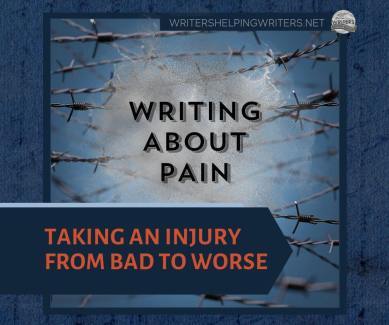
In a story, when we put characters in dangerous or unfamiliar situations, they can get hurt, and when they do, it makes everything harder. They might have reduced mobility, the pain may make it hard to think, or the injury makes something they must do (win a fight, escape a threat, or keep their independence, for example) all but impossible.
Injuries and pain lead to problems, meaning they can be great for a story as they generate tension and conflict. Too, readers become more invested when something happens to a character, either because they care about the character and want them to be okay, or the incident leads to a rush of schadenfreude because a nasty character is getting what they deserve.
A writer’s mindset is all about How can I make things more difficult for this character? meaning it can be tempting to pile on the injuries and pain, but this can lead to other story problems. Too many ouchies and a character’s not going to be able to continue their quest, and that means not achieving their goal (or worse, causing the author to manufacture a ‘Hail Mary rescue’ that feels contrived). Or, if injuries are piling up like a serial killer’s body count, readers might get angry and feel the author is going too far. So we really want to find the sweet spot of making things hard, not impossible for the character.
Sometimes a better route than “more injuries” when you’re trying to make a character’s life challenging is to simply add a complication.
In the right circumstances, even a small injury can cause big problems. Cuts get infected. Bites can be poisonous. A blister can make it hard to run flat out to escape. Complications are not only realistic, they can raise the stakes and make readers worry, generating tension.
How to take an injury from bad to worseBeing unable to treat the injury. Some problems require medical intervention, but that doesn’t mean your character can access help. They might be on a remote hiking trail, in the middle of a farmer’s field, or simply unable to go to the hospital because if they do, it will alert the authorities. When a character can’t get the help they need, this not only ramps up the pain, it ramps up the consequences.
An underlying condition. Does your character have a clotting disorder that means a cut on their thigh won’t close? Are they being treated for an illness that leaves them fatigued? Will that concussion re-awaken difficult side effects caused by a previous traumatic brain injury? When you want to make an injury more complicated and particularly dangerous for a character, think about what underlying conditions or illnesses they may have that will make it harder to function.
Infection. Your story doesn’t need to be in the middle of a Zombie Apocalypse to cause characters to worry about viruses. Wounds exposed to the wrong conditions can cause fever or delirium, compromising your character’s ability to function and make rational decisions. Untreated, infection can lead to blood poisoning, gangrene, or even flesh-eating disease. Yikes.

Reduced mobility. If your character breaks a bone or injures their back, they may be unable to move on their own. This can put a strain on others who must step in to help, causing delays or forcing them to expend energy they need for other things. If your character is on their own, say with a broken leg at the bottom of an embankment, an inability to move much will become a crisis if they cannot source food, water, or find help. Sitting or laying prone too long can also increase blood flow related issues, making injuries worse and healing slower.
Muscle tears or nerve damage. A bike accident, overdoing it at the gym, or a pell-mell flight from a pack of wild dogs can mean more than bruises. A muscle tear or nerve damage can affect mobility and dexterity, and generate high levels of pain. These injuries take time to heal, and sometimes require special treatments or even surgery. So think carefully about how this type of complication might play out in the story. Your character might be damaged in a way that their recovery may not fit the timeline for conflict resolution.
Scar tissue. Everyone has a few scars, but what if your character’s reduces function in some way, or even disfigures them? What will this mean as far as their dexterity and range of movement, or how other people view them? Will it close doors because they’ve lost their edge as far as a skill goes, or reveal a lack of depth in their relationships because people can’t accept this change?
Extreme swelling. Injuries cause tissue to swell, and if this happens to a body part that is confined somehow (a swollen foot stuck in a boot, or a wedding ring cutting off circulation due to a broken finger), it can cause intense pain and the need for intervention to avoid losing the limb.
Improper healing. Sometimes a character can’t get help when they need it, and the injury starts to heal in a way that is less than ideal. Bones may not be fully aligned as they knit together, causing a limp or malformation. A deep cut that can’t be stitched in time may result in a scar, loss of sensation, or reduced function.
Fears or phobias being triggered. Characters who have suffered past trauma may have their deepest fears awakened when an injury occurs, especially if the injury reminds them of a painful experience. Or they may have a phobia of doctors, hospitals, dying, or another fear that makes them resistant to being treated.
Addictions. A character in recovery will not want to risk medication that may cause a relapse. This might mean having to bear extreme levels of pain to stay drug free, or having no choice but to have drugs in their system so a surgery can be performed, or an infection is stopped before it can spread.

Making the injury worse. When characters are in danger or there’s a ticking clock, they can’t take it easy. A strain the character must put up with to escape a threat can become something much worse if it isn’t treated. Over time, increased fatigue or reduced strength will make a character unstable and more prone to additional injuries, too.
Ideally, injuries should push characters to think of creative solutions to their problems.When they do, this makes for good reading. Too, characters who don’t give up (even though they may want to) are the ones readers admire most!
Other posts in this pain series:The Three Stages of Awareness
Different Types to Explore
Describing Minor Injuries
Describing Major and Moral Injuries
Invisible Injuries and Conditions
Factors that Help of Hinder the Ability to Cope
The post Writing About Pain: Taking an Injury from Bad to Worse appeared first on WRITERS HELPING WRITERS��.
September 19, 2023
How To Write A Psychological Thriller Without Frying Your Own Brain
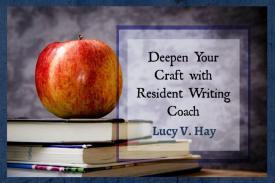
Whether you’re a fan of the genre or looking to try your hand at writing one, a psychological thriller can be fun to both read AND write. But what goes into making these stories so captivating?
A psychological thriller is a story that combines elements of suspense, mystery, and even horror to create an unsettling and often terrifying experience for the reader. These stories typically revolve around characters who are dealing with some kind of mental or emotional disturbance, which leads them to behave in erratic or dangerous ways.
I’ve written six such novels, with a seventh out next year in 2024. Here are my top tips …
1) Start With an Intriguing Premise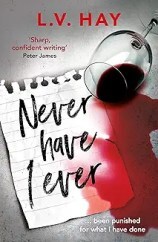
Your story should start with a bang! Draw your readers in with an enticing and mysterious premise. Ask yourself what dark secrets your characters are hiding, or what could drive someone to commit a crime.
In my psychological thriller Never Have I Ever, it starts with my protagonist receiving an anonymous note. It reads: ‘Never have I ever … been punished for what I have done.’ But what could THAT be about?? Eeek!
2) Create Believable CharactersPsychological thrillers center around characters who are often flawed and damaged, which can make them difficult to create.��Pay attention to their backstories, motivations, and needs so you can make them fully fleshed-out individuals.
It’s important to ensure that your characters feel real and relatable, even if they’re not always likeable. (Remember, female characters are often accused of being ‘unlikeable’ anyway, no matter what they do! I call this the ‘female burden’).
3) A Compelling ProtagonistA compelling protagonist is particularly important in this genre. It’s important to choose someone readers can empathize with and root for throughout the novel.
Create a detailed character sketch of your main character, including their motivation for solving the mystery or problem at hand. (Lots of writers struggle with characterization, so I’ve created a free masterclass on creating characters which you can grab HERE).
4) Intriguing Secondary CharactersIn addition to a well-developed protagonist, your story will also need believable and interesting secondary characters. These characters should contribute to the plot in a meaningful way, without taking away from the mystery itself.
Since secondary characters should HELP or HINDER the protagonist, I always recommend putting your secondary characters on ‘team protag’ or ‘team antag’. This way, you can be sure secondaries are pulling their weight in the story.
5) Build Suspense SlowlyA successful psychological thriller takes its time in ramping up the suspense and tension. Keep your readers guessing by slowly revealing information about your characters and their pasts, while also raising the stakes as the story progresses.
Avoid rushing things … a slow burn really is key in this genre! Make sure you study structure and plotting archetypes so you can make the most of tension and suspense.
I always recommend the book The Seven Basic Plots by Christopher Booker for this, but there’s plenty of helpful resources to help you – including this site, Writing Helping Writers!
6) A Richly Described Setting
The setting of your story is just as important as the characters populating it. Choose a location that is rich in history and detail, then use vivid descriptions to bring it to life for readers.
In my books, I frequently write about seaside towns out of season. This is because my characters are often outsiders, cut off from others. If you’ve ever been in such a place in winter, you will know seaside towns are often shut down and cut off during the winter months. This is an example of the storyworld reflecting the characters’ lives and dilemmas.
7) Choose Your Ending VERY CarefullyThe ending of a psychological thriller is especially important���it should be both climactic and satisfying without being too predictable or pat. Twist endings can be particularly effective in this genre, so long as they make sense within the context of the story as a whole.
Never, ever, ever fly in an ending out of the ‘left field’. Sometimes it can help to START with your ending and plot backwards to ‘find’ the beginning when it comes to twists.
Editing, Polishing and Setting Your Story FreeEditing, polishing and setting your story free are all important aspects of writing a psychological thriller. It is important to keep your readers engaged by making sure your story is well-written and edited.
There are many ways to edit your story, but it is important to take your time and do it right. Here are some tips for editing, polishing and setting your story free:
1) Take Your Time!Don’t rush through the editing process. Once you have written your first draft, put it away for a few days or weeks before you start editing. This will give you some distance from the material and allow you to come back with fresh eyes.
2) Be RuthlessWhen you are editing, be ruthless in cutting out anything that doesn’t move the story forward or add anything new. Get rid of any unnecessary details or scenes that drag on too long.
3) Make Sure Everything Makes SenseAs you are editing, make sure that everything in the story makes sense. Check for any plot holes or inconsistencies and fix them before moving on.
4) Pay Attention to DialogueDialogue is an important part of any story, but it is especially important in a psychological thriller. Make sure that each character’s dialogue sounds natural and believable. Listen for any awkward phrases or stiffness in the dialogue and revise accordingly.
5) Let Others Read ItI know it’s scary, but you need others’ opinions and suggestions on your work. I always recommend going as far as you can with honing your craft, peer review, or writers’ group critiques BEFORE you pay for notes or feedback though. There’s no point paying to get feedback on the basics, get your money’s worth!
Good Luck! One Stop for Writers
One Stop for Writers is here to help!
Check out these powerful tools that help you create believable characters, including the largest show-don’t-tell descriptive database that fleshes out motivations, negative traits, emotions, settings, and many other items in this post.
Get 25% off any plan until September 22!
The post How To Write A Psychological Thriller Without Frying Your Own Brain appeared first on WRITERS HELPING WRITERS��.
September 16, 2023
Writing About Pain: Factors that Help or Hinder the Ability to Cope
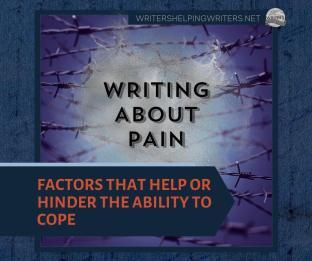
We know that pain is an unfortunate part of life. And if you���re doing your job as an author, your character will be put through the ringer, experiencing many painful events���big and small���throughout their story. We���ve talked about the kinds of physical pain they could encounter and how to describe that. But how will your character respond to their pain?
Much like a fingerprint, each person���s pain response is unique. It will be determined by a combination of factors���some that are controllable and some that aren���t. Remember, it���s the character that will draw readers in and keep them engaged, but only if their reactions are believable and consistent. So it���s imperative to know the most sensible responses for your character.
Passive FactorsThere are many ways a character can react to physical discomfort, and a lot of them will be subconscious. Their ability to handle their pain will be based on some passive factors that are out of their control and are already running in the background when things go south. Because these factors will dictate your character���s pain response, it���s important to familiarize yourself with them and know what they look like for your character.
Pain ToleranceThis is defined as the maximum amount of physical suffering a person can handle. The higher your character���s pain tolerance, the more they���ll be able to withstand the discomfort they experience. This threshold varies from one person to the next and is established by a number of variables, such as genetics, past experiences with pain, and how much stress the character is dealing with when adversity strikes.
PersonalityYour character���s values and dominant traits will play a part in how they respond to pain. Just think about the natural reactions you���ll get from different kinds of characters: melodramatic vs. stoic vs. needy vs. someone who���s always playing the martyr… The traits and qualities your character values will play a large part in how they handle discomfort, so take those into consideration.
Imperative ResponsibilitiesIf the circumstances surrounding their pain are simple, the character���s response can be straightforward. For instance, if they tumble down a flight of stairs with a roommate nearby, they can focus on their physical state and what to do next. But what if they fell, alone, trying to get upstairs to a crying baby? What if they���re a federal agent who was attempting to neutralize a sniper who is now free to keep shooting?
When an injury threatens the well-being of others or keeps the character from an imperative duty, they may be able to ignore or minimize their pain until they���ve accomplished what needs doing. On the flip side, becoming incapacitated while others are in danger may actually worsen the pain.
Pharmacological FactorsAlcohol, medications, and illegal drugs obviously dull pain. This is why drunk drivers can gravely injure themselves in a car accident and walk away without feeling much of anything. If your character is wounded while they���re under the influence, this will impact what they feel and how they react.
Responses That Help Control Pain in the MomentNow that we���ve had a look at the latent factors that contribute to a character���s pain response, let���s turn our focus to active reactions, starting with those that are most helpful in controlling and lessening discomfort���both in the moment and in the aftermath of a painful event.
Maintaining a Positive Mindset
Positive thinking keeps the character in a forward-focused mindset, concentrating on what can be done and what actions to take. It engenders a sense of empowerment and control as they work toward solutions and betterment. A positive mindset also reduces stress and anxiety, which are known to make pain worse.
Utilizing Mind-Body TechniquesThese techniques allow the character use the mind to positively influence the body. Meditation, prayer, relaxation techniques, and deep breathing exercises can mitigate pain and help the character become more centered and calm.
Distracting ThemselvesIn the midst of even a minor injury, the pain won���t go away completely. Sometimes, the best thing a character can do is to focus on something else. Exercises such as mentally preparing a grocery list or summarizing the storyline of a favorite movie can be beneficial in taking the mind off the pain. If the injury allows, the character can also engage in a distracting hobby. Reading a book, working on a puzzle, or playing a game won���t negate the pain, but activities like these can push it into the background and make it less intense.
Responses That Help Control Pain During RecoveryPursuing a Healthy LifestylePhysically healthy bodies heal faster, with a quicker secession of pain. To this end, making nutritious food choices, prioritizing sleep, and reducing stress can improve the character���s overall health and aid in pain management. Exercise is another important factor because while it makes the body stronger and especially helps to manage chronic discomfort, it also released endorphins, which can have a pain-relieving effect.
Educating and Self-AdvocatingHealthcare providers are wonderful resources, but they don���t know everything. A character who researches their own injuries and physical limitations will increase their knowledge and likely find new treatment options. This form of self-advocacy can result in a sense of empowerment, staving off despair, depression, and hopelessness.
Volunteering and Altruism
When pain is ongoing and/or intense, it’s often more comfortable to stay at home and avoid the activities that aggravate it. But studies show that when we shift our focus from ourselves to others, amazing things happen with our mindset and our outlook on life. In this way, volunteering and serving others can have a mitigating effect on pain. At the very least, acts of altruism can make physical discomfort more bearable as the character finds a greater sense of purpose.
Attending TherapyTherapy is a magical tool for helping people find better ways of dealing with their problems. For a character trying to cope with pain, a therapist can provide great insight into the mental and emotional processes that can be adopted to minimize the discomfort or put into a proper perspective.
Responses that Hinder Pain Mitigation in the MomentFor every positive reaction, there are a multitude of negative responses that hinder rather than help. It���s easy for people in pain to resort to whatever works to make it go away. But many of these methods are only temporary or create ancillary problems. Here are some common pain responses that will thwart your character���s healing and possibly make their situation worse.
Focusing on the NegativeFor someone battling chronic or intense discomfort, it���s easy to fall into negative thinking by becoming obsessed with the pain, catastrophizing, and becoming cynical. But just as positive thinking has positive benefits, negative thinking begets negative outcomes in the form of increased anxiety and depression, and decreased motivation and self-worth���all of which make healing harder.
Hiding the PainPeople often aren���t comfortable expressing their pain���maybe because it occurred in public and they���re embarrassed or don���t want people to fuss over them. They might need to be strong if they���re with their kids or in a position of authority. Or they could be worried about consequences, such as losing a starting spot on a sports team if they can���t perform. There are many reasons why someone might choose to mask their pain, so it���s worthwhile exploring those possibilities.
Not Seeking HelpWhile many people run to the doctor when pain sets in, there are some characters who will avoid treatment. This may be true for someone who
Is in denial about their conditionIs highly independent and doesn���t want to rely on others for helpCares deeply about what others think and doesn���t want to appear weakRefusing to seek treatment or get help won���t expedite healing and the cessation of pain. It also can make a minor injury worse if treatment is needed.
Responses that Hinder Pain Mitigation During RecoveryMaking Unhealthy ChoicesJust as healthy habits can encourage healing and minimize pain, an unhealthy lifestyle often does the opposite. Responding to pain by taking up smoking, compulsively eating, or turning to drugs and alcohol can aggravate existing conditions (and the associated pain) or create new health issues that will make life even more difficult.
Being Driven by Fear and Avoidance
If your character is struggling with a high level of discomfort, it���s normal for them to avoid any activities that might make it worse. But ongoing avoidance often results in a sedentary lifestyle that can actually increase someone’s sensitivity to pain, achieving the opposite result.
Having Unrealistic ExpectationsIn some situations, people will be living with a certain level of pain for the rest of their lives. The discomfort can be managed, but only if the character���s expectations are realistic. Hoping for an impossible outcome, such as a complete recovery with no more pain, will result in disappointment and an inability to recognize and appreciate small gains.
As you can see, there are many factors that can impact a character���s pain response. Some of the groundwork will be laid before the injury occurs, and other reactions are more controllable. Knowing the possibilities can help you choose the right responses for your character, both at the time of injury and in the aftermath.
Other posts in this pain series:
The Three Stages of Awareness
Different Types to Explore
Describing Minor Injuries
Describing Major and Moral Injuries
Invisible Injuries and Conditions
The post Writing About Pain: Factors that Help or Hinder the Ability to Cope appeared first on WRITERS HELPING WRITERS��.
September 13, 2023
Phenomenal First Pages Contest – Guest Editor Edition
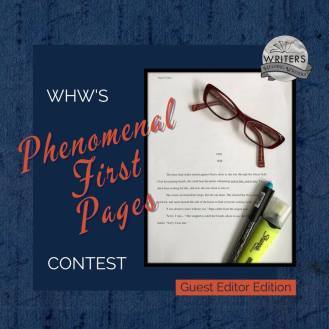
Hey, wonderful writerly people! It���s time for our monthly critique contest. This month, we have a HUGE prize.
3 winners will receive feedback on 20 pages from a professional editor. So exciting!
PLEASE NOTE: We’ve changed our process for entering this contest.
If you’d like a chance to win feedback, use this link or click the graphic below to reach our ENTRY FORM:
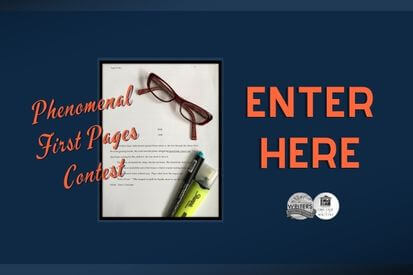 ENTRY FORM
ENTRY FORMWhen you enter by form, double check that your email is correct so I’ll be able to contact you if I draw your name. (If I can’t reach you, you’ll have to forfeit your win.)
The editor you’ll be working with:Stuart Wakefield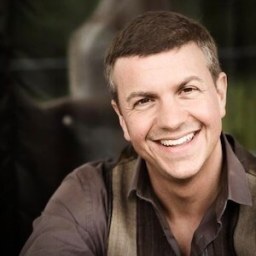
With 26 years in theatre, broadcast media, and coaching under my belt, I have a visceral understanding of what makes stories work, and I���d like to share it with you because writing a novel doesn’t always have to be difficult and daunting, especially if it���s your first time. Understanding the process, getting started, and seeing it all come together can seem like an impossible mountain to climb.
As an Author Accelerator Certified Book Coach, I’m passionate about helping new writers craft stories with passion and purpose, momentum and meaning. I have an MA (Distinction) in Professional Writing, and my debut novel, Body of Water, was one of ten books long-listed for the Polari First Book Prize. My latest novel, Behind the Seams, was a 2021 BookLife Fiction Prize Contest semifinalist.
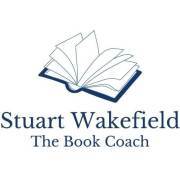
My first TV show is airing on the UK’s Channel 4 in 2023.
So, if you have a story in your heart, just waiting to be shared with the world, I���m here to offer you guidance and support from developing your story right through to pursuing publication. You can find my website, blog, and free self-editing cheat sheet right here: https://linktr.ee/thebookcoach
**��My new course, “Emotional Echoes: The Art of Character Backstory,” opens Monday 18th September and is available for the special price of $47 until Monday 2nd October – when it goes up to $97! **��
Contest GuidelinesComments will NOT enter you in this contest. To enter, fill out this contest form. (One entry per person.)Have your first 20 pages are ready to go. 1-inch margins, double-spaced, and 12pt Times New Roman font. Feedback will consist of in-line comments concerning what’s not working and what is.You’ll need to supply a synopsis (a rough one is fine) so Stuart has context for his feedback. This contest only runs for 24 hours, so enter by form ASAP.We use Random.org to draw winners, and post the names in the comments tomorrow morning. If you win, I’ll be in touch!
If you���d like to be notified about our monthly Phenomenal First Pages contest, consider subscribing to our blog (see the right-hand sidebar).
A huge thank you to Stuart, and good luck to all! I can’t wait to see who the winners will be. 
PS: To amp up your first page, grab our First Pages checklist from One Stop for Writers. And for more help with important opening elements, visit this Mother Lode of First Page Resources.
The post Phenomenal First Pages Contest – Guest Editor Edition appeared first on WRITERS HELPING WRITERS��.
September 12, 2023
Writing Techniques: Use and Abuse of ���Lampshading���
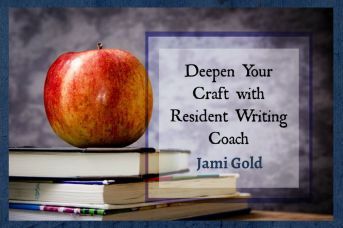
As storytellers, we usually want to keep readers immersed in our story. However, we���ve probably all written lines that we worry will break readers��� suspension of disbelief, such as with story events that might feel too clich��, coincidental, or incongruent. Obviously, we can try to fix the issue by changing those elements, but what if they���re necessary for the story we want to tell?
In that case, we might simply hope that the strength of our surrounding lines or story flow will carry readers past that point without pulling them out of the narrative. But there���s another option that may help overcome a reader���s awareness: the writing technique of ���lampshading.��� Let���s explore what the lampshade technique is and how we can use it (and not abuse it) in our stories.
What Is the ���Lampshade��� TechniqueBelieve it or not, the lampshade/lantern/lampshade-hanging technique is just this: Purposely call attention to a clich��, illogical, or contrived element, often in characters��� dialogue. By calling attention to something that threatens a readers��� suspension of disbelief, we���re essentially telling readers, ���Yep, the story world thinks these elements are odd too. Just roll with it.���
The TV Tropes site includes many examples, which point out how this technique isn���t new:
Sir Toby Belch: Is’t possible?
Fabian: If this were played upon a stage now, I could condemn it as an improbable fiction.
��� Shakespeare, Twelfth Night
In addition to simply using self-awareness to point out issues, lampshading can sometimes also take the opportunity to answer or justify how the situation makes sense. For example, to defuse readers��� skepticism or criticism of an event, a character might share further information after the fact, such as explaining unknown motivations:
Lampshade: ���Yeah, I���m glad we won, but why did Klaus suddenly decide to help us?��� Susan threw up her hands. ���That makes no sense. He never wanted our team to win.���
Justification: Paula pointed down the field to the opposing team. ���See that girl? Cynthia broke up with him last night���ugly scene from what I heard. Maybe he wanted her team to lose more than he didn���t want us to win.���
Depending on circumstances, lampshading can create moments that come off as winking, hilarious, clever (or too-clever-for-its-own-good), meta, lazy, handwaving away weak writing, etc. So we need to understand when lampshading will help or hurt our writing and story.
Lampshading Might Hurt Our Story When���
Lampshading done well helps keep readers immersed in our story, but lampshading done poorly risks pulling readers out of our story even more than if we had just left our writing alone.
Situations where lampshading can hurt our story or writing include:
Our story���s style is serious or sincere, so even mild or well-done lampshading risks a tonal change of being too-clever, meta, or jokey.Our story���s narrative is strong and/or readers of our genre won���t question the plot tropes/clich��s, so lampshading risks an impression of ���apologizing��� for lines or elements that readers may not even notice if we don���t point them out.The questionable elements are part of a strong emotional moment in our story, so lampshading risks undercutting���or at least interrupting���the emotions we wanted to evoke (such as in the game-winning example above).Our story naturally keeps readers at a distance���less engaged or immersed���so any lampshading, especially meta, fourth-wall-breaking, or too-clever-by-half moments (unless, of course, that���s the kind of story we���re trying to tell), risks preventing readers from taking anything seriously (e.g., if our characters don���t seem fully invested and care about the story���s events, readers might not care either).The questionable elements are part of a major or important moment in our story, so lampshading, with its ���don���t worry about it��� and ���just roll with it��� attitude, risks giving readers the impression that the moment isn���t important.There���s no story at all without the questionable elements, so lampshading that emphasizes the issue can make the entire story feel weak or ���fake.���Our characters��� reactions are believable within the story world, so lampshading risks an impression that we aren���t confident in our writing, worldbuilding, or characters.Most importantly, as alluded to in that last bullet point, we don���t want to lampshade something simply because we���re not confident in our writing. Once per story, we might need to move the plot along with a contrived situation that we���re not entirely happy about, and maybe that event could use a lampshade, just to keep things moving. But lampshading due to self-consciousness can feel defensive, like we���re trying to avoid any-and-all criticism or essentially apologizing for our work. Instead, we should fix the problem so we can feel at least somewhat confident in our writing.
How to Properly Use Lampshading
Given all the above risks, we might wonder why we���d ever use the lampshading technique. However, done well, the technique can create a ���we���re all in this together��� bond with readers. In fact, lampshading can deepen readers��� immersion, preventing readers��� natural disbelief or skepticism about events.
So what are some ways to ensure we���re using the lampshade technique well? We can���
Use the right level of lampshading (minor vs. major, explicit vs. subtle, frequency, etc.), matching the story and its needs.Maintain the narrative flow of the story through the lampshading (unless we���re not trying to be subtle with our use), as the more interruptive the lampshade is, the more noticeable it is.Keep any comments or reactions true to the character and/or believable for character and story world.Make characters react the way readers would react to the incongruent events, which can make our characters more relatable.Ensure the events surrounding the lampshading are still earned by the story, rather than using the lampshading to kick off a lazy-writing sequence of events.Anticipate readers��� thoughts of alternate plot directions, such as ���why don���t they try XYZ���, and lampshade why that wouldn���t work to keep readers on the intended plot path.Maintain the ���fourth wall��� between the character���s lampshading commentary and the reader, such as by having the character comment about a character in a movie they���re watching (e.g., the boy and grandfather framing device of The Princess Bride).Ensure the lampshaded events add value for the reader, as they���ll be less interruptive if readers want to accept the events and move on from the issue.Keep the story���s style/tone and the target audience in mind with regards to frequency and placement of the technique, as even in stories where a winking, self-referential type of joke fits the tone, it���s possible to overdo, undercut important or emotional moments, or limit the appeal of the humor style (e.g., the lazy-writing complaints about recent Marvel movies).Final Thoughts about LampshadingThe lampshade technique shouldn���t be used as a general Get-Out-Of-A-Plot-Hole-or-Lazy-Writing Card. Hanging a lampshade to flippantly dismiss real problems in a story doesn���t make them go away.
But when done well, lampshading can help us keep readers engaged with our story:
At its least, readers see the lampshade as a fun wink rather than bad writing that causes them to disengage from the story.At its best, we can use it with a plot event that feels like a plot hole to readers���but that we know will have a strong, perfectly logical explanation later���to let readers know this ���hole��� is part of the plan and they should continue trusting us and our storytelling. It hints to readers that they���re still missing a puzzle piece to understanding the story so just enjoy the journey.In short, lampshading done well is about keeping our readers��� trust, adding value that proves our story is worthy of their suspended disbelief. *smile*
Want to learn more about subtle vs. explicit lampshading or see examples? Visit my companion post!
Have you heard of the lampshade technique before? Did you know how to use it properly, or were you worried about the risks? Do you have any questions about the technique or how to use (and not abuse) lampshading?
The post Writing Techniques: Use and Abuse of ���Lampshading��� appeared first on WRITERS HELPING WRITERS��.
September 9, 2023
Character Type & Trope Thesaurus: Loner
In 1959, Carl Jung first popularized the idea of archetypes���”universal images that have existed since the remotest times.” He posited that every person is a blend of these 12 basic personalities. Ever since then, authors have been applying this idea to fictional characters, combining the different archetypes to come up with interesting new versions. The result is a sizable pool of character tropes that we see from one story to another.
Archetypes and tropes are popular storytelling elements because of their familiarity. Upon seeing them, readers know immediately who they’re dealing with and what role the nerd, dark lord, femme fatale, or monster hunter will play. As authors, we need to recognize the commonalities for each trope so we can write them in a recognizable way and create a rudimentary sketch for any character we want to create.
But when it comes to characters, no one wants just a sketch; we want a vibrant and striking cast full of color, depth, and contrast. Diving deeper into character creation is especially important when starting with tropes because the blessing of their familiarity is also a curse; without differentiation, the characters begin to look the same from story to story.
But no more. The Character Type and Trope Thesaurus allows you to outline the foundational elements of each trope while also exploring how to individualize them. In this way, you’ll be able to use historically tried-and-true character types to create a cast for your story that is anything but traditional.
 Loner
LonerDESCRIPTION: This character lives an isolated life due to their inability to relate to or connect with others. Loners can be��Rebels��(and vice-versa), but because the former are more comfortable with their background status-quo, they don’t typically seek to effect major change.
FICTIONAL EXAMPLES: Jane Eyre (Jane Eyre), the Grinch (How the Grinch Stole Christmas),��Boo Radley (To Kill a Mockingbird), Eleanor Oliphant (Eleanor Oliphant is Completely Fine)
COMMON STRENGTHS: Adventurous, Alert, Cautious, Confident, Focused, Independent, Industrious, Intelligent, Introverted, Meticulous, Observant, Organized, Pensive, Philosophical, Private, Quirky, Studious, Talented
COMMON WEAKNESSES: Abrasive, Cynical, Grumpy, Inhibited, Insecure, Judgmental, Needy, Nervous, Obsessive, Self-Destructive, Selfish, Stubborn, Suspicious, Tactless, Timid, Workaholic, Worrywart
ASSOCIATED ACTIONS, BEHAVIORS, AND TENDENCIES
Preferring to observe rather than engage with others
Living on the fringes
Avoiding crowds and large social gatherings
Having a quiet voice
Having understated mannerisms
Preferring to work alone (and being more efficient that way)
Being misunderstood
Being socially awkward
Expecting to be underestimated by others
Naturally distrusting others
Being secretive
SITUATIONS THAT WILL CHALLENGE THEM
Being forced to interact in a group
Being transferred to a new city where new friendships will have to be made
Having an extroverted or rowdy friend whose antics force the loner into the spotlight
TWIST THIS TROPE WITH A CHARACTER WHO���
Is a loner sometimes and a people-person in other situations
Is an excellent public speaker
Is forced into a leadership role and turns out to be very good at it
Has an atypical trait: cocky, funny, mischievous, sentimental, superstitious, vain
CLICH��S TO BE AWARE OF
The lone wolf character who doesn’t need anyone and is perfectly happy on their own
Jaded, cynical, emo loners
Other Type and Trope Thesaurus entries can be found here.
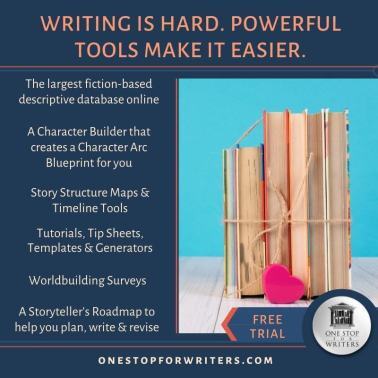 Need More Descriptive Help?
Need More Descriptive Help?While this thesaurus is still being developed, the rest of our descriptive collection (16 unique thesauri and growing) is accessible through the One Stop for Writers THESAURUS database.
If you like, swing by and check out the video walkthrough for this site, and then give our Free Trial a spin.
The post Character Type & Trope Thesaurus: Loner appeared first on WRITERS HELPING WRITERS��.
September 7, 2023
Writing About Pain: Invisible Injuries and Conditions
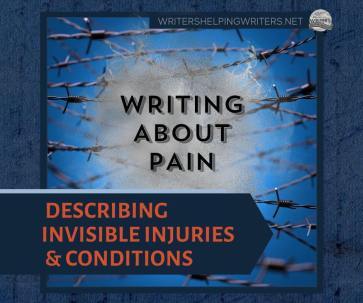
In this series on pain, we’ve covered everything from minor injuries to major and mortal injuries. But there’s another source of pain that can push our characters to the edge of coping: invisible injuries and conditions.
When readers see a bruise, cut, or gunshot wound, it’s easier for them to fill in the blanks about what happened, and imagine the pain that goes with it. But when the source is internal, writers have to work harder to connect the dots for readers, especially if the character themselves is unaware of what’s causing their distress, or they choose to mask their pain.
So what are some examples of internal conditions or injuries?A concussion, brain injury, stroke, or another condition affecting the brain. Maybe your character fell on the ice and seemed to have escaped with only a few bruises, until a headache or migraine shows up. There are changes in vision and nausea. Or they’re having trouble forming thoughts, words, or remembering things.
Internal organ damage, bleeding, or ruptures. Physical trauma, being poisoned or exposed to toxic elements, a surgical complication, bone fractures, or even an ectopic pregnancy can all be sources of internal bleeding and damage. While initially a character may not realize they are in distress, it doesn’t take long to know something is off as internal bleeds can cause significant pain, and manifest in different ways depending on where they are located. Organ damage can cause a rapid or irregular heartbeat, make the character feel nauseous, lead to confusion and lethargy and fever and chills. Untreated, organ damage can lead to organ failure.
Chronic Pain. Your character may have fibromyalgia, chronic fatigue syndrome, or recurring pain from an old injury or condition without visible markers. Because the pain is chronic, it may impair their ability to enjoy everyday things, cause mood swings and irritability.
Neck injuries (like whiplash) can be caused by things like car accidents, pinched nerves, contact sports, or being shaken, and don’t necessarily have visible signs of swelling. Characters can experience stiffness and debilitating pain in the neck, shoulders, and head.

Hearing conditions that lead to sensitivity. Some characters may feel pain when exposed to certain noises, due to hearing loss or other conditions. They could even have Misophonia (an aversion to specific sounds that causes panic attacks and causes one to feel as though they are losing their sanity).
Neurologic disorders, diseases or lesions. A character with a condition like Multiple Sclerosis, Parkinson’s disease, Long Covid or even a spinal injury may experience neurological pain, paresthesia, tingling or numbness that is difficult to manage and impacts their quality of life.
Autoimmune Disorders. A character who has a condition like lupus, rheumatoid arthritis, IBD, or Crohn’s disease will experience internal inflammation and invisible symptoms that can range from fatigue, joint pain, fevers, and uncomfortable digestive issues.
Cardiovascular Conditions: Heart conditions, such as arrhythmias, certain types of heart disease, and attacks can cause pain in the chest, upper back, and neck, lead to discomfort from experiencing indigestion and nausea, and even cause dizziness. Some arrhythmias have no signs, others can be quick and fatal.
Digestive issues. Irritable bowel syndrome (IBS), gastric ulcers, food poisoning, gall stones and a variety of other gastrointestinal conditions create discomfort in the form of cramps, diarrhea, nausea, and bloating.
Other forms of disease like cancer. Tumors pressing against organ, bones and tissues can be quite painful, and the radiation or chemotherapy no less so.

Depression, post-traumatic stress disorder (PTSD), borderline personality disorder (BPD) and other mental conditions and struggles. Not all invisible conditions cause physical pain; many cause emotional distress, anxiety, panic attacks, etc. as well. The psychological battles being fought may not be visible to others, but this doesn’t make the emotional pain your character feels any less real or debilitating.
The little things. Pulled muscles. Toothaches. Infections. Minor nerve pain. Even small hurts can cause your character to feel irritable and ruin their day.
Tips for showing internal injuriesRegardless if a character doesn’t know what the invisible injury is, or they are purposefully hiding it, we still need to help readers realize something’s off. Here are a few ideas on how to do that.
Seed some hints. Is there something a character is avoiding, like bending down, getting out of bed, or cleaning the house? This can plant a clue that pain is a factor.
Give the character a few tells. Is your character consistently rubbing at their neck rolling their wrist, or they’re extremely irritable for no reason?
Know the signs of internal conditions. This one is one of the most important. Each non-visible condition or injury will have specific symptoms for pain. Do your research to make the character’s behavior authentic.

Show their struggle to manage or hide pain. Is your character overcompensating, breathing in a strained way, or struggling to form words?
Have the character talk it out. If the character is around someone they feel comfortable sharing with, they can talk about what they feel, but only if it makes sense for your character to be open like this.
Have a character make an observation. Characters can be very observant. A pointed question, “Is there something wrong with your knee? You keep rubbing it.”
Reveal something they can’t do. There’s nothing worse than discovering something you used to do is no longer possible: tying a shoe. Being sociable at a family barbecue. Talking about anything without becoming emotionally upset.
Add urgency. Internal injuries get worse when not treated. This can happen slowly, or quickly. Raise the stakes by showing your character’s condition worsening, making it crucial to find an answer to what’s hurting the character.
Invisible injuries and conditions have a superpower: they create tension.Visible signs give readers a good idea about what’s wrong and how bad the pain will be, but when it’s something invisible, the reader wonders, what’s wrong? How bad is it? And because they’ve experienced that feeling of ‘not knowing’ in their personal life, they will feel unease until the story provides answers.
Internal injuries can also be a false front. Readers might believe a character has gotten away unscathed, only to discover a clock inside them is ticking, and if they don’t get help soon, the consequences will be significant…or fatal. So the next time you need to hobble your characters with pain, consider an invisible injury!
Other posts in this pain series:
The Three Stages of Awareness
Different Types to Explore
Describing Minor Injuries
Describing Major and Moral Injuries
The post Writing About Pain: Invisible Injuries and Conditions appeared first on WRITERS HELPING WRITERS��.
September 5, 2023
Strategies for Smooth Scene Openings

If the opening line of a scene is the doorway to the party, what follows is the welcoming handshake and introductions that draw readers into the mix. Effective scene openings extend beyond the fireworks of a provocative opening hook, ushering readers into the new space with no awkward stumbles or feeling out of place.
Here���s how to whisk readers effortlessly into a scene���s flow.
Go in Late ���The first technique is all about judging the point at which to enter the scene. Screenwriters have a saying: Go in late, get out early. Don���t overexplain on either end.
Since stories are about significance (why did the character make those choices, and how did it matter?), scenes should be constructed of significant stuff���stuff that matters, not all the characters��� dull daily duties.
Cut out the boring stuff. Short of a few scenes way back in the first act of your book while you���re establishing the character���s normal world, it���s almost never interesting to show a character waking up, getting dressed, drinking coffee, and getting ready for the scene. Get to the point. Readers come to your book for engaging story action, not the mundane business they���ve already slogged through themselves so they can sit down and read.

Transitions are a common tripping point. You can almost always do away with travel to the next location in the story (unless the journey itself is the point). Travel, arrivals, greetings, goodbyes���those are interstitial moments, not the story itself. None of that merits your precious word count.
Scenes dip in and out of the story at key points of conflict and tension, when things are popping that actually change what���s happening. Spend your time showing the characters doing things that affect the story line, not merely getting ready. It���s like a theatrical play���don���t show the stagehands changing the scenery, just raise the curtain on the next scene.
Aim to begin on the upswing into the conflict or juiciest part of the scene. Some scenes need a little more set-up, but you���ll be surprised how quickly readers catch on if you simply dive in.
This technique of going in late (or in medias res, in the middle of things) is often honed during revision. Write first, hone later. You���ll be surprised how much you can slice away without shaking readers��� ability to follow where the story moves next. Save anything you remove during revisions in your graveyard file, in case you need parts of it again later.
Test out shortened scenes on readers who don���t know your story. They may not know the details of the story, but can they slide into the spirit of the scene anyway? Could you prune away still more? You can always add removed content back a snippet at a time.
Bonus Tip: ��� Get Out EarlySpeaking of petering out, the reverse of ���go in late��� holds true on the back end of the scene: Get out early. Once you���ve hit the peak���the conflict or surprise or complication���get the heck out of Dodge. Don���t overstay the scene���s welcome by dragging out the characters��� reactions (reaction/emotion, dilemma, and decision). This isn���t the time for lengthy debates …
… unless, of course, it is. If the characters and readers need time to grapple with the ramifications of what just happened, indulge in a full sequel scene.
Anchoring Scenes: The 3 WsOnce you���ve chosen the right place to begin the scene, it���s time to invite readers in. Readers can���t sink into immersion until they���re oriented in the story. Whose view are they seeing this scene from? Where and when are they?
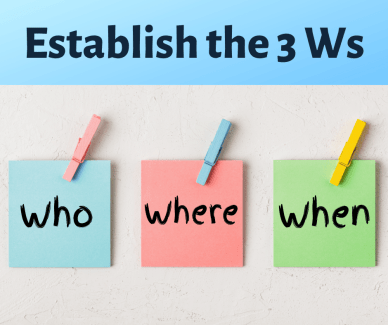
Within the first page of every scene���preferably within the opening paragraphs���ground readers by establishing the 3 Ws.
WHO the viewpoint character is (and WHO ELSE is present in the scene)WHERE the scene is taking placeWHEN the scene is taking place, or a sense of how much time has passed since the last scene1. WHO Nothing in a scene makes sense until readers have context for what they���re reading. Whose experience is this? Establish the viewpoint character unambiguously within the first paragraph or two, ideally within the first two sentences.
Readers usually assume that the first character named in a scene is the viewpoint character. Positioning the viewpoint character in the opening has the added benefit of launching them into motion, doing or speaking or considering or noticing. Now viewpoint character has agency in driving the scene.
Also near the top of a scene, establish who else is present. Ideally, this should happen within the first page or so. You want to avoid the sort of confusion when some character pops off on the last page with a snarky observation, only readers didn���t even realize they were there. A glimpse of each character is sufficient, even a collective mention such as The others armed themselves with plastic forks and swarmed the defenseless box of cake on the counter.
2. WHERE A scene will feel like a snippet acted out in front of a green screen on a movie soundstage if readers don���t know where it���s unfolding. Don���t infodump the details in a steaming lump at the front of the scene. Parse it out.
The things the viewpoint character notices should reflect their personal mindset: their knowledge, priorities, taste, immediate agenda, hopes, fears ��� What is the viewpoint character doing here in this scene? They���re not sitting around and blinking around at a static world; they should be actively engaged in something that���s obviously headed somewhere interesting.
3. WHEN Pull readers across the chasm between scenes by seeding the next scene opening with cues as to how much time has passed. Unless the timeline is integral to the plot, it���s not necessary to be overt about this. In slower stories or sections, a mention of late-afternoon sun or a brisk autumn breeze gets the job done. The shorter the story���s overall timeline, the more granular you���ll need to be with these references.
Many books benefit from timestamps at the beginning of each chapter (22:58:07 11/12/2093, Bridge of the Atlantis) to help orient readers. Caveat: Not every reader notices or absorbs timestamps, and even those who do are unlikely to parse out the number of days or weeks between dates to grasp the relative passage of time (with the exception of something like the breathless hour-by-hour countdown of a thriller).
Revising Scene OpeningsPro revision tip: Make a single revision pass dedicated exclusively to tightening scene openings. Don���t get sucked into editing past the first few paragraphs. Try starting at the end of the manuscript and working backward scene by scene, forcing you to tackle each scene in its own right rather than in relation to the previous scene.
First, check to see that you���ve started each scene as late as possible, just before things get juicy. Since every scene should cause the next one to come about, like a chain of dominoes, you could also use this revision pass to check that scenes wrap up promptly (���get out early���), before the momentum has a chance to start petering out.
Next, move back to the scene opening to check for the 3 Ws: who, where, when.
Done.
Continue to work your way through the manuscript one scene at a time from back to front, checking only for scene opening issues. The result will be a smoother read that invites readers into the action every time.
The post Strategies for Smooth Scene Openings appeared first on WRITERS HELPING WRITERS��.
September 2, 2023
Character Type & Trope Thesaurus: Christ Figure
In 1959, Carl Jung first popularized the idea of archetypes���”universal images that have existed since the remotest times.” He posited that every person is a blend of these 12 basic personalities. Ever since then, authors have been applying this idea to fictional characters, combining the different archetypes to come up with interesting new versions. The result is a sizable pool of character tropes that we see from one story to another.
Archetypes and tropes are popular storytelling elements because of their familiarity. Upon seeing them, readers know immediately who they’re dealing with and what role the nerd, dark lord, femme fatale, or monster hunter will play. As authors, we need to recognize the commonalities for each trope so we can write them in a recognizable way and create a rudimentary sketch for any character we want to create.
But when it comes to characters, no one wants just a sketch; we want a vibrant and striking cast full of color, depth, and contrast. Diving deeper into character creation is especially important when starting with tropes because the blessing of their familiarity is also a curse; without differentiation, the characters begin to look the same from story to story.
But no more. The Character Type and Trope Thesaurus allows you to outline the foundational elements of each trope while also exploring how to individualize them. In this way, you’ll be able to use historically tried-and-true character types to create a cast for your story that is anything but traditional.
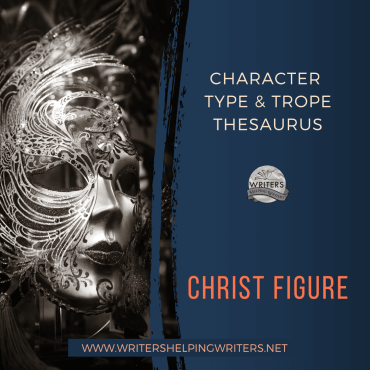 Christ Figure
Christ FigureDESCRIPTION: This character is someone who makes the ultimate sacrifice to save someone else. During the course of the story, they may be symbolic of Jesus Christ or simply model his characteristics,��such as selflessness, generosity, mercy, and forgiveness.��
FICTIONAL EXAMPLES: Aslan (The Lion, the Witch, and the Wardrobe), John Coffey (The Green Mile), Gandalf (the Lord of the Rings trilogy), Simon (Lord of the Flies)
COMMON STRENGTHS: Calm, Confident, Courageous, Decisive, Empathetic, Focused, Gentle, Honorable, Humble, Idealistic, Inspirational, Just, Kind, Loyal, Mature, Merciful, Protective, Responsible, Spiritual, Trusting, Unselfish, Wholesome, Wise
COMMON WEAKNESSES: Fanatical, Humorless, Hypocritical, Inflexible, Judgmental, Know-It-All, Manipulative, Melodramatic, Obsessive, Reckless
ASSOCIATED ACTIONS, BEHAVIORS, AND TENDENCIES
Being a good listener
Being counter-cultural
Being innocent or even na��ve
Not being ego-driven
Being willing to make sacrifices to help others
Frequently standing up for what they believe in
Being a natural leader
Having a strong spiritual side
Enjoying solitude
Defending the vulnerable
Remaining calm in high-pressure situations
Thinking of the greater good rather than their personal desires
Valuing justice
Speaking wisely; giving good advice
Never giving up hope
Being driven by purpose
Being able to find meaning in suffering
Using non-violent means to achieve their goals
Being persuasive
Being quick to forgive others
Having an overall positive outlook
Rebelling against the system if it’s unjust
Having an underdeveloped sense of humor
Being overly preachy or moralistic
Viewing problems through an overly simplistic lens
Being out of touch with the culture
Coming across as different or odd
Being misunderstood
SITUATIONS THAT WILL CHALLENGE THEM
Discovering the person they’re sacrificing themselves for is despicable
Having no choice but to resort to violence
Running afoul of the law because of their actions
Facing an injustice they can’t do anything about
Seeing many people in need and not being able to help them all
Working with someone who is frustrating or annoying (because they need constant support, are always negative, are prejudiced, etc.)
Learning new information that makes them realize they shouldn’t follow through on a promise they made
TWIST THIS TROPE WITH A CHARACTER WHO���
Isn’t male
Is loud, has a good sense of humor, and is the life of the party
Has flaws or personal demons that interrupt their attempts to do good
Struggles with doubt
Has an atypical trait: nature-focused, quirky, scatterbrained, childish, witty, indecisive, etc.
CLICH��S TO BE AWARE OF
The completely na��ve and wholesome Christ figure
The Christ figure who has an overt message to share
A Christ figure with no flaws or internal conflicts who is portrayed as the ideal human
The Christ figure who throws out his arms during the moment of final sacrifice, making the symbol of the cross as he dies
Other Type and Trope Thesaurus entries can be found here.
 Need More Descriptive Help?
Need More Descriptive Help?While this thesaurus is still being developed, the rest of our descriptive collection (16 unique thesauri and growing) is accessible through the One Stop for Writers THESAURUS database.
If you like, swing by and check out the video walkthrough for this site, and then give our Free Trial a spin.
The post Character Type & Trope Thesaurus: Christ Figure appeared first on WRITERS HELPING WRITERS��.
August 31, 2023
Writing about Pain: Describing Major & Mortal Injuries
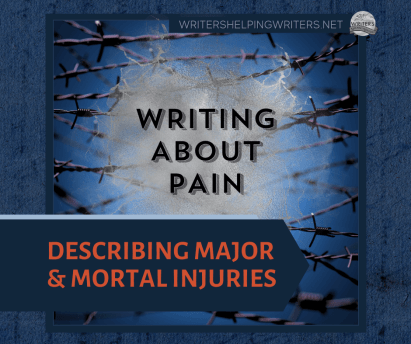
As you may be aware, we���re smack dab in the middle of a series of posts on writing a character���s pain, and today’s is a doozy. Our last post explored common minor injuries your character might encounter and the pain associated with those. Today, we���re leveling up to discuss the severe and even fatal injuries that could befall someone in your story. But before we get to that morbid list, let���s talk about a common life-threatening thread that runs through them all and will be an issue for most characters undergoing serious physical harm.
Physiologic ShockMany severe injuries result in a loss of blood or reduced oxygen in the blood supply. Sometimes this is a natural result of the trauma, when too much blood leaves the body or vascular system and there isn���t enough circulating to the organs. In other situations, the body redirects blood to where it���s most needed in the moment, which leaves other parts of the body untended. In either case, the vital organs aren���t getting the blood and/or oxygen necessary to sustain them.
Because shock so often accompanies physical trauma, a character who���s been seriously hurt will likely experience this symptom, so it���s important to know what it looks like. Common indicators associated with this kind of shock are as follows:
Shallow breathingUncontrollable shiveringIrregular heartbeatClammy skinDilated pupilsLight-headednessNauseaMental confusionYou���ve probably heard that people can die of shock, but that���s not technically true; they die from the severe injury that interrupted their blood or oxygen flow, with shock being a secondary symptom from the injury. Shock is just an obvious indicator that something is terribly wrong and that immediate measures need to be taken to get the issue under control before too much damage is done.
Now let���s take a closer look at the most common mortal injuries that could befall your character, as well as the pain and other processes associated with them.
Stab WoundsThis form of puncture wound can cause damage to blood vessels, organs, or the spine, resulting in rapid blood loss, organ failure, and potential death. Wounds to the chest and abdomen are particularly dangerous because of the vital organs that can get nicked. But stab wounds to the extremities are still serious because of potential vascular damage.
Associated pain: The patient may experience sharp or stabbing pains from tissue damage, as well as burning and shooting pains associated with injury to the nervous system.
Gunshot Wounds
Gunshot wounds are another kind of puncture wound. But unlike stab injuries, these wounds can cause greater damage because of their high-velocity nature and the bullet���s ability to bounce around and hit multiple targets, resulting in rapid blood loss, internal bleeding, organ failure, and potential death.
Associated Pain: A patient with a serious gunshot wound and minimal nerve damage will experience the same kinds of pain as someone who has been stabbed. As blood loss increases and shock sets in, the pain may diminish until the patient loses consciousness.
DismembermentThis type of cutting injury occurs when a part of the body is severed from the whole. Accidental dismemberment is often instantaneous, with the victim being unaware of it until it���s done.
Associated Pain: There will be significant and severe pain in the area of the dismemberment as severed nerves are exposed. But shock will kick in very quickly, numbing some of the pain and possibly creating a dissociative effect to separate the patient from their pain.
High-Impact Traumas
These injuries are the result of the body���s collision with another moving or stationary object. Car accidents, falls, sports injuries, and physical violence are common causes that can result in so many problems, including broken bones, a crushed airway, brain trauma, collapsed lungs, torn blood vessels, and displaced organs.
Associated Pain: If the injury is localized���say, a hand that���s crushed in a workplace accident���the pain will be focused on that area. Pain resulting from organ injury might be described as aching, squeezing, or cramping in quality, but because the organs are located close to each other in the body���s trunk, it may be hard for the patient to pinpoint exactly where it���s occurring.
Severe BurnsThird-degree burns that cover a significant portion of the body are often life-threatening because of the risk of infection, edema, dehydration, and other complications. These differ from first- and second-degree burns, which can often heal with at-home treatment, leaving only minor (if any) scarring.
Associated Pain: Despite their severity, third-degree burns destroy nerves, which often results in less or lower-quality pain in the affected area. However, there will be considerable pain in the surrounding areas as the severity of the burn lessens to second- and first-degree burns where the nerves are intact. And, unfortunately, treatments in the form of topical applications, the changing of dressings, debridement, and skin grafts will intensify the character���s discomfort after the initial trauma has passed.
Asphyxia InjuriesThese injuries deprive the body of oxygen, often resulting in damage to the brain and organs and leading to death. Types include strangulation, suffocation, choking, drowning, smoke inhalation, asthma attacks, and anaphylaxis associated with allergies.
Associated Pain: In each scenario, the kind of injury will determine the pain involved. Smoke inhalation will cause headaches and pain in the throat and chest as irritants are ingested and swelling ensues. Strangulation will cause pain in the throat and the feeling of pressure building in the brain as the flow of oxygen is cut off. Asthmatics in the throes of an attack often describe it as feeling like an elephant is sitting on their chest. The causes of asphyxiation vary widely, so careful research is required to know the kind and quality of pain your character will experience.
Poisoning
This injury occurs when someone swallows, touches, inhales, or otherwise comes in contact with a toxic substance that can result in serious injury or death. This may include substances that are poisonous by nature (cyanide, arsenic, etc.) and those that become toxic when they���re misused, such as household cleaners or prescription medications.
Associated Pain: A character���s response to a poisoning will depend on the kind and amount involved. Common painful responses include abdominal pain, headache, vomiting, diarrhea, and seizures. If poisoning is in the cards for one of your characters, thorough research into the kind of poison and the body���s response to it is needed to write their pain realistically.
Electric Shock InjuriesThe body is essentially a complex electrical system, so any influx of high-voltage electricity can wreak serious havoc. The injuries associated with electric shock are myriad, including internal and external burns, brain trauma, spinal injuries, chest pain, muscle pain, and damage to the heart.
Associated Pain: Shocks of this nature don���t tend to last very long. But in the moment, a character undergoing a severe electric shock can experience burning sensations, a clamping and seizing of the muscles, respiratory paralysis, arrhythmia, and possibly cardiac arrest.
These are the body���s physical pain responses to fatal and near-fatal injuries. But as we learned in the second installment of this series, pain goes beyond the physical. And while near-death and deathbed experiences can be notoriously quick, they can also bring moments of clarity, where thought and emotion come to the forefront.
Mental, Emotional, and Spiritual Responses to Major InjuriesFear and Anxiety: regarding their pain, the outcome of their circumstances, the probability of death, and how their leaving could impact loved onesDetermination: Determining to fight with everything they have to survive; redoubling any mental or physical effortsDespair: giving in and giving up their hold on lifeDissociation: A sense of being separated from their pain and any physical sensation, as is the case in an out-of-body experience; viewing their circumstances from outside of themselves, which provides the ability to think and process what���s happeningReflection: The ���life flashing before your eyes��� scenario, where the character is able to review their choices and experiences, both good and badRegret: Wishing they had done more with their time, they���d taken or not taken certain actions, they���d worked harder to resolve certain conflicts or build key relationships, or they could have more time with loved onesDoubt: Questioning what they���ve always believed about death and the afterlifeSpiritual Clarity: A person of faith being comforted as they recall that there���s something and someone waiting for them; a character returning to the spiritual beliefs of their childhoodAcceptance: Gaining a sense of peace regarding the reality of their situation; embracing the inevitableAs is the case with so many aspects of storytelling, someone���s pain level and intensity during a severe or fatal injury will depend on a variety of factors relating both to the situation and the character. Deciding what the specific situation will be is your first step. The second is knowing what kind of pain is involved. And finally, you���ll need to figure out the character���s response to it. Hopefully this post has provided a basis for making those decisions.
Other Posts in the Writing About Pain Series
The Three Stages of Awareness
Describing Minor Injuries
The post Writing about Pain: Describing Major & Mortal Injuries appeared first on WRITERS HELPING WRITERS��.
Writers Helping Writers
- Angela Ackerman's profile
- 1022 followers



